Home Recording on the Cheapity Cheap
Eds. Note: All About The Guitar will be on hiatus until Cullen gets settled in his new home. For his last article (for now), Cullen shares with us the gift of homemade music. Enjoy.
Back in 2002, I got a wild hair about doing some home recording. There is and was a lot of information on the Web about how to do it right and economically. Well, I had issues with them.
First, I couldn’t afford to buy any of the equipment they suggested. I couldn’t afford a new sound card, an external input device or really nice recording software like Acid or Pro Tools. Secondly, not only could I not afford to set up a real cheap home studio, I didn’t really want to either. I wanted to see if I could overcome the obstacles given the equipment I had on hand.
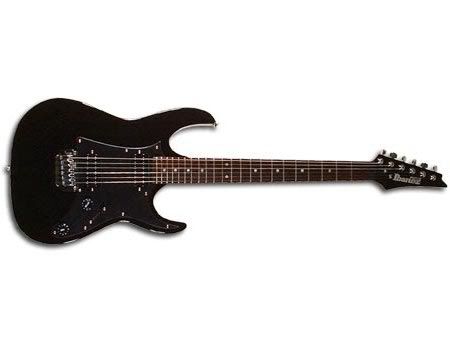 What did I have: A computer with the regular accoutrements (a Celeron 400MHz, so no barn burner, though this was 2002), an Ibanez Gi0 guitar, a Dean Playmate bass, a Fender Bullet Reverb practice amp, and Cool Edit Pro multi-track recording software (I also have a Rogue bass amp, but didn’t use it).
What did I have: A computer with the regular accoutrements (a Celeron 400MHz, so no barn burner, though this was 2002), an Ibanez Gi0 guitar, a Dean Playmate bass, a Fender Bullet Reverb practice amp, and Cool Edit Pro multi-track recording software (I also have a Rogue bass amp, but didn’t use it).
So, I had tools. Not great tools, but enough to accomplish the task. For those who are interested in playing around with multi-track recording and don’t have any real experience, Cool Edit is a neat program to use. It’s very user friendly and easy to learn. Cool Edit is now Adobe Audition, but the old 2.1 version is still readily available. There are lots of free audio editing programs out there though. Audigy is great and is something I use now because CE 2.1 won’t install on XP.
Before I tackled the problem of getting sound into the computer, I decided I needed to find a way to lay down a drum track. It was important to me to get the most realistic sounding drums I could without paying any money for software. I wound up running across a program called DRUMS. I used the demo version (linked at the bottom of the article). It’s a VERY time consuming process to lay down a drum track. BUT, I did discover the ability to copy and paste bars, which sped up the process a bit. If you’re doing a pretty simple song, it’s not that hard. I couldn’t imagine doing something really complex though.
(Editor’s note: I have searched for the DRUMS program again recently and found it. But the newer version is sub-par compared to the version I used 5 years ago. The drums sound far more sampled and not full. Sucks.)
So, I had a drum program, the ability to record the drums (if you have the demo version, you have to play the drum track and record it using an audio recorder on your computer; with the full version you can export directly to WAV), so I decided to play around with the program a bit. I found some neat sample drum beats and quickly laid down a simple pattern with repetitive fills. I used it as a click track to play guitar along with it, and decided I should attempt to lay down guitar and bass tracks.
This created a completely new dilemma. The little Fender has an export port. And I tried to run a line from the “External Speakers” jack into the computer’s Aux. Input and Microphone input. However, I can only assume that the amp’s line must act like a pre-amp or something, because I could never get a usable guitar sound going this route. There was either too much feedback or the signal was not loud enough to be usable.
I had to think around this problem. How could I get a signal that sounds as good as the amp (and that little Fender amp does sound good) into the computer? Then I started looking at the computer’s microphone (the standard one that came with the computer). And I had a moment of inspiration. “What if I mic’d the amp?” I thought.
 Having a little bit of an idea of acoustics (not much though), I wound up taking a large box and putting the amp into it. I further put two pillows and a quilt in the box to absorb any echo and put the mic barely in the box at a corner opposite the amp.
Having a little bit of an idea of acoustics (not much though), I wound up taking a large box and putting the amp into it. I further put two pillows and a quilt in the box to absorb any echo and put the mic barely in the box at a corner opposite the amp.  This setup, as white-trash fabulous as it may be, worked quite well. I was able to lay down guitar and bass tracks this way and synch it all up in Cool Edit. Took about an hour to do all this (after the drum track was already done). I am not linking to this experiment because it sucks donkey balls. But it proved to me the process was sound.
This setup, as white-trash fabulous as it may be, worked quite well. I was able to lay down guitar and bass tracks this way and synch it all up in Cool Edit. Took about an hour to do all this (after the drum track was already done). I am not linking to this experiment because it sucks donkey balls. But it proved to me the process was sound.
Now I was cooking. I might have been cooking with an MRE heater, but it was still a form of cooking. I was at a point where I had to decide what I wanted to record. It had to be something simple (because I can play nothing but), but something I liked also. After a few different ideas, I decided on Some Kind of Hate by The Misfits. I chose the song primarily because the drum track was very easy.
Regardless of ease on the drums, it was still a time-consuming process. The demo version of DRUMS does not allow you to save, so if you commit to it, you have to do the whole song at once. I believe it took me two or three hours to get it down. But once I did, the rest of the process was pretty easy.
I did this all at night, after the wife and kids went to bed … this is an important note for later.
After setting all the equipment up (pretty quick when you leave everything prepped, it took maybe 10 minutes) I recorded the guitar track. It’s important to note that you have to keep track of your input and outputs (via your computer’s audio control panel). ‘Cause if you want to use the drum track as a click track, you cannot have to mute the record portion of that input, which I think would be wave. The mic would be Line In or microphone, depending on what all inputs you have.
Amazingly, I got the bass done in one take and it only took two or three takes to get the guitar down. Simple songs are lovely.
I mixed down the guitars and drums and came up with a good sounding instrumental track. I normalized everything and that was a mistake. The short little solo in the middle lost it’s punch and I had to play around with crap for a while to get it right. I finally got it punched up enough, but it never sounded quite right after that. I also added some Chorus and a little more distortion to the track via Cool Edit’s effects. CE’s chorus effects are awesome. I can think of very little music that can’t benefit from Chorus.
 Now came a new problem … vocals. I have a real Nady mic I was going to try to use, but because of the bad sound card, I could get nothing useable. What I did not think of, and, in retrospect I wish I had, was to run the vox through my practice amp. But, I wound up singing dry directly into the computer mic. This didn’t work out very well. Singing through the amp I could have “heard” myself better, not so this way. Plus, it was about 2 or 3 in the morning and I was trying to keep my voice down. So the vox turned out like crap.
Now came a new problem … vocals. I have a real Nady mic I was going to try to use, but because of the bad sound card, I could get nothing useable. What I did not think of, and, in retrospect I wish I had, was to run the vox through my practice amp. But, I wound up singing dry directly into the computer mic. This didn’t work out very well. Singing through the amp I could have “heard” myself better, not so this way. Plus, it was about 2 or 3 in the morning and I was trying to keep my voice down. So the vox turned out like crap.
I tried a lot of things to punch up the vox, but regardless of what I did, I couldn’t fix the fact that I was flat and lacked dynamic range because I wasn’t singing at my normal volume. So I turned down the vox in the mix and let it ride.
The sad thing is, I did this to prove that I could get a decent-sounding recording given pretty standard equipment that any musician would have. After proving that to myself, I haven’t done any more recording and I wish I would.
Cullen is working hard on a new cover of The Final Countdown.
 #8 Metallica - Ride the Lightening: I’m kind of upset at putting a Metallica album over a Megadeth album, but hell, it happens. As far as its importance, Ride the Lightening secured Metallica’s name in the lexicon of great metal acts. Sure, Kill ‘em All was a great album, but there were other bands doing similar things, and no one knew if they could follow up KEA with a solid sophomore release. Ride the Lightening shattered doubts and left many screaming for more. There is a feeling that permeates both this album and Master of Puppets. I don’t know exactly how to describe it, but it’s in the production quality of the album. It’s not quite perfect, but at the same time, it’s perfectly not perfect. It’s an ambience that does creep up your spine, much as they describe in “Creeping Death.” Personally, I think Metallica got it so right with this album and Puppets, that I have been thoroughly disappointed with everything since.
#8 Metallica - Ride the Lightening: I’m kind of upset at putting a Metallica album over a Megadeth album, but hell, it happens. As far as its importance, Ride the Lightening secured Metallica’s name in the lexicon of great metal acts. Sure, Kill ‘em All was a great album, but there were other bands doing similar things, and no one knew if they could follow up KEA with a solid sophomore release. Ride the Lightening shattered doubts and left many screaming for more. There is a feeling that permeates both this album and Master of Puppets. I don’t know exactly how to describe it, but it’s in the production quality of the album. It’s not quite perfect, but at the same time, it’s perfectly not perfect. It’s an ambience that does creep up your spine, much as they describe in “Creeping Death.” Personally, I think Metallica got it so right with this album and Puppets, that I have been thoroughly disappointed with everything since.  #6 Black Sabbath – Paranoid: Wow, it was hard to narrow down what Sabbath album I wanted here. I mean, I knew I wanted #6 to be Sabbath, and I had originally put We Sold our Soul for Rock and Roll, but since that’s a greatest hits album, I decided it was kind of cheating. So, I went with Paranoid on the strength of the title track, War Pigs, Iron Man, and Fairies Wear Boots. Great stuff. These songs probably defined what metal was to become. The use of power chords in minor keys set the mood that would permeate metal albums to this very day. There is probably no band that has been more influential on metal music.
#6 Black Sabbath – Paranoid: Wow, it was hard to narrow down what Sabbath album I wanted here. I mean, I knew I wanted #6 to be Sabbath, and I had originally put We Sold our Soul for Rock and Roll, but since that’s a greatest hits album, I decided it was kind of cheating. So, I went with Paranoid on the strength of the title track, War Pigs, Iron Man, and Fairies Wear Boots. Great stuff. These songs probably defined what metal was to become. The use of power chords in minor keys set the mood that would permeate metal albums to this very day. There is probably no band that has been more influential on metal music. may have been better musicians than Pantera, but there has never been a band that can make you feel exactly what they are feeling like Pantera could. There has never been a band before or since that can translate a boot to the freaking head like Pantera. Perhaps that’s a good thing.
may have been better musicians than Pantera, but there has never been a band that can make you feel exactly what they are feeling like Pantera could. There has never been a band before or since that can translate a boot to the freaking head like Pantera. Perhaps that’s a good thing. album had the production value of some of Megadeth’s later albums, this would definitely be the #1 album.
album had the production value of some of Megadeth’s later albums, this would definitely be the #1 album. in the late ‘80s, he might very well still be languishing in semi-loserville waiting for his VH1 special instead of standing astride a thriving musical empire. Zakk is not only a gifted guitarist, he has one of the most unique sounds in all of music, EVER. You can tell Zakk is playing in fewer than 20 seconds. His guitar tone, scale choices, rhythm style and his signature pinch harmonics (that screaming note that permeates his music) all give him away and it’s a good thing.
in the late ‘80s, he might very well still be languishing in semi-loserville waiting for his VH1 special instead of standing astride a thriving musical empire. Zakk is not only a gifted guitarist, he has one of the most unique sounds in all of music, EVER. You can tell Zakk is playing in fewer than 20 seconds. His guitar tone, scale choices, rhythm style and his signature pinch harmonics (that screaming note that permeates his music) all give him away and it’s a good thing.  #13 Dream Theater - Metropolis Pt. 2: Scenes From a Memory: This is actually my all-time favorite album. However, in the interest of the list, it’s down further than I’m comfortable putting it. In fact, this is such a personal choice, that it’s higher than most people would put it. Most folks would have Queensryche’s Operation: Mindcrime in this spot. However, since Queensryche is, or was, rather, progressive metal, I put DT here because they completely and in every way pwn Queensryche.
#13 Dream Theater - Metropolis Pt. 2: Scenes From a Memory: This is actually my all-time favorite album. However, in the interest of the list, it’s down further than I’m comfortable putting it. In fact, this is such a personal choice, that it’s higher than most people would put it. Most folks would have Queensryche’s Operation: Mindcrime in this spot. However, since Queensryche is, or was, rather, progressive metal, I put DT here because they completely and in every way pwn Queensryche. Back to RIP … this album is amazing! When it came out, I wore the tape out in about two weeks. I had to record a copy from a friend after that. I tried like mad to try and learn how to play songs off it, but it was too damn complex for me. Still is. I mean, if you have any doubts about Megadeth’s musical abilities, listen to this album, it’s damn near progressive metal. These guys pull no punches in speed or complexity of composition. Of course, when the track calls for it, the lay down some simple riffs also. It’s a matter of taste and Mustaine knows how to write a tasty lick. Can you tell who’s one of my favorite bands?
Back to RIP … this album is amazing! When it came out, I wore the tape out in about two weeks. I had to record a copy from a friend after that. I tried like mad to try and learn how to play songs off it, but it was too damn complex for me. Still is. I mean, if you have any doubts about Megadeth’s musical abilities, listen to this album, it’s damn near progressive metal. These guys pull no punches in speed or complexity of composition. Of course, when the track calls for it, the lay down some simple riffs also. It’s a matter of taste and Mustaine knows how to write a tasty lick. Can you tell who’s one of my favorite bands? #10 Judas Priest – British Steel: Another difficult choice because Screaming for Vengeance was very good. But, come on, “Breaking the Law” is on British Steel. What Priest song has had more play and is more influential than that? “Living After Midnight” is also a hell of a song. I kind of hate to admit this, but I’m not that big of a Priest fan. Their influence and musical ability is undeniable, but I’ve always been rather pissed at their production quality. Here you have one of the arguably biggest metal bands ever and their recordings sound like they were recording inside of cardboard boxes. People always tell me, “Well consider the time frame and the equipment they had to work with.” Well, you know what? Screw you! The Ramones, hell The Sex Pistols were recording in the same time frame, with lower budgets and their production quality has always been spot fucking on. Why does this piss me off so much? Because every Judas Priest album up to Painkiller was mixed where Rob Halford’s voice sounding tinny and the guitars sounded ball-less lacking low end. Just think if there was a fullness to the recording … this shit would have stomped any other band around. So, why are they #10 if I bitch about them so much? Because even with the crappy recordings people still sing their shit and they influenced almost every metal band that came after them.
#10 Judas Priest – British Steel: Another difficult choice because Screaming for Vengeance was very good. But, come on, “Breaking the Law” is on British Steel. What Priest song has had more play and is more influential than that? “Living After Midnight” is also a hell of a song. I kind of hate to admit this, but I’m not that big of a Priest fan. Their influence and musical ability is undeniable, but I’ve always been rather pissed at their production quality. Here you have one of the arguably biggest metal bands ever and their recordings sound like they were recording inside of cardboard boxes. People always tell me, “Well consider the time frame and the equipment they had to work with.” Well, you know what? Screw you! The Ramones, hell The Sex Pistols were recording in the same time frame, with lower budgets and their production quality has always been spot fucking on. Why does this piss me off so much? Because every Judas Priest album up to Painkiller was mixed where Rob Halford’s voice sounding tinny and the guitars sounded ball-less lacking low end. Just think if there was a fullness to the recording … this shit would have stomped any other band around. So, why are they #10 if I bitch about them so much? Because even with the crappy recordings people still sing their shit and they influenced almost every metal band that came after them.  When I first started thinking about how to go about compiling the list, I thought I’d just narrow down my top 25 and put them “in no particular order.” Though, I guess that’s kind of cheating. So, I have decided to commit to a list. My criteria were threefold: What did this album mean to metal? What did this album mean to me? Did it really rock?
When I first started thinking about how to go about compiling the list, I thought I’d just narrow down my top 25 and put them “in no particular order.” Though, I guess that’s kind of cheating. So, I have decided to commit to a list. My criteria were threefold: What did this album mean to metal? What did this album mean to me? Did it really rock? #22: Anthrax - Among the Living: Anthrax is a mainstay metal band to this day (in fact, they are back to their original lineup). It is unfortunate that their chosen name became controversial in recent years, but they have always stomped. And that is the best description of Anthrax’s tunes – music to stomp by.
#22: Anthrax - Among the Living: Anthrax is a mainstay metal band to this day (in fact, they are back to their original lineup). It is unfortunate that their chosen name became controversial in recent years, but they have always stomped. And that is the best description of Anthrax’s tunes – music to stomp by. #16 Danzig - Danzig: Again a somewhat personal choice. There are plenty of bands from this era that had a similar sound to Danzig’s blues-based metal (though his sound has changed in recent years). But Glenn Danzig is important to metal primarily because of his punk band The Misfits. Their sound significantly impacted many of the early ‘80s LA metal bands – Metallica primarily.
#16 Danzig - Danzig: Again a somewhat personal choice. There are plenty of bands from this era that had a similar sound to Danzig’s blues-based metal (though his sound has changed in recent years). But Glenn Danzig is important to metal primarily because of his punk band The Misfits. Their sound significantly impacted many of the early ‘80s LA metal bands – Metallica primarily. Everyone on post knew the security guy. He was well-liked and loved by many of the civilian and local national employees who’d worked with him for nearly, and in some cases, over a decade.
Everyone on post knew the security guy. He was well-liked and loved by many of the civilian and local national employees who’d worked with him for nearly, and in some cases, over a decade. So, as part of a guilty pleasure/full confession, I ask, what songs make you cry?
So, as part of a guilty pleasure/full confession, I ask, what songs make you cry? Dallas, Deep Ellum, actually, is home to one of the best guitarists in music today, Jim Heath. Better known to the masses as
Dallas, Deep Ellum, actually, is home to one of the best guitarists in music today, Jim Heath. Better known to the masses as 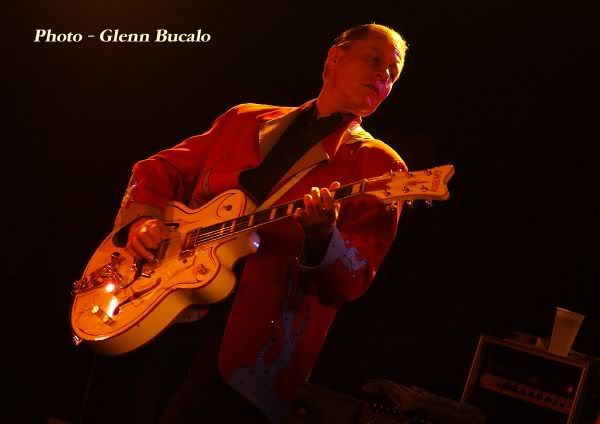 Seeing them on the show was a catalyst. The next time I was over at one friend's place, I asked him if he had any of their albums. He had both It's Martini Time and Spaceheater. I absorbed them both and bought them myself. Over time I got their entire catalog.
Seeing them on the show was a catalyst. The next time I was over at one friend's place, I asked him if he had any of their albums. He had both It's Martini Time and Spaceheater. I absorbed them both and bought them myself. Over time I got their entire catalog.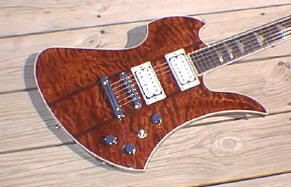 Wood for your guitar. This is a highly complex and emotionally charged topic for guitar players and builders. Some people try to use physics to explain the uses of wood, others use mojo. Some build for economy, others build for looks. I simply cannot go into all the ins and outs of this topic, there isn’t the space and I don’t have the time. Here, I’m only going to talk about the basics and only cover electric guitars.
Wood for your guitar. This is a highly complex and emotionally charged topic for guitar players and builders. Some people try to use physics to explain the uses of wood, others use mojo. Some build for economy, others build for looks. I simply cannot go into all the ins and outs of this topic, there isn’t the space and I don’t have the time. Here, I’m only going to talk about the basics and only cover electric guitars. 
 The majority of the guitar body will be made with a different wood like mahogany and the quilted maple will just be a cap. If the cap is thick enough, it will effect the sound of the guitar. However, there are lots of guitar companies that only use a thin maple veneer top. This looks pretty, but doesn't do anything to the sound. Thick maple caps can really brighten up the tone of a guitar.
The majority of the guitar body will be made with a different wood like mahogany and the quilted maple will just be a cap. If the cap is thick enough, it will effect the sound of the guitar. However, there are lots of guitar companies that only use a thin maple veneer top. This looks pretty, but doesn't do anything to the sound. Thick maple caps can really brighten up the tone of a guitar. 
 As with other figured maples, spalted maple is primarily used as a cap on a guitar body. However, spalted maple cannot really be used for anything else. It has a brittle structure and is not strong enough to be used for anything that could put strain on it. It looks gorgeous though, and you can get all kinds of figuring. This guitar is one of
As with other figured maples, spalted maple is primarily used as a cap on a guitar body. However, spalted maple cannot really be used for anything else. It has a brittle structure and is not strong enough to be used for anything that could put strain on it. It looks gorgeous though, and you can get all kinds of figuring. This guitar is one of 
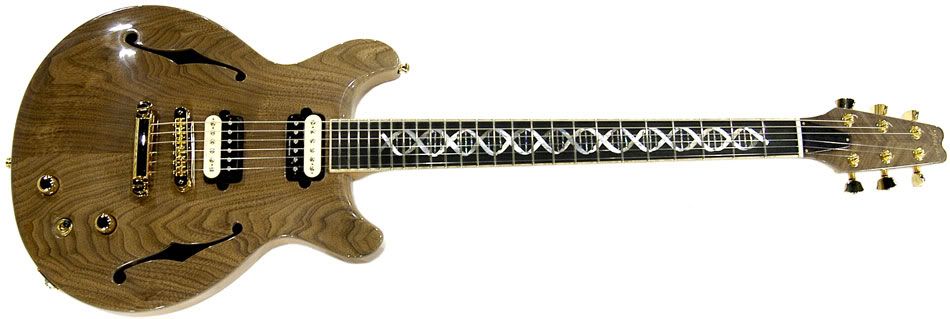

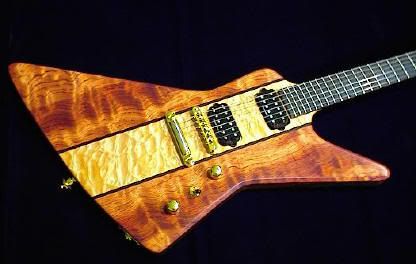

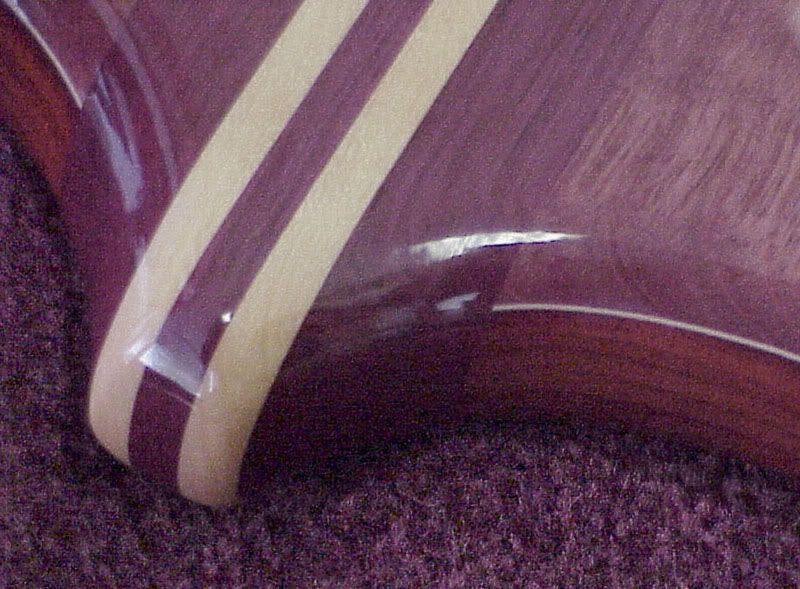 So, most of the time, you see PH used as accent stripes though the neck or body. Sometimes folks make guitar knobs out of it. You can see on this
So, most of the time, you see PH used as accent stripes though the neck or body. Sometimes folks make guitar knobs out of it. You can see on this 





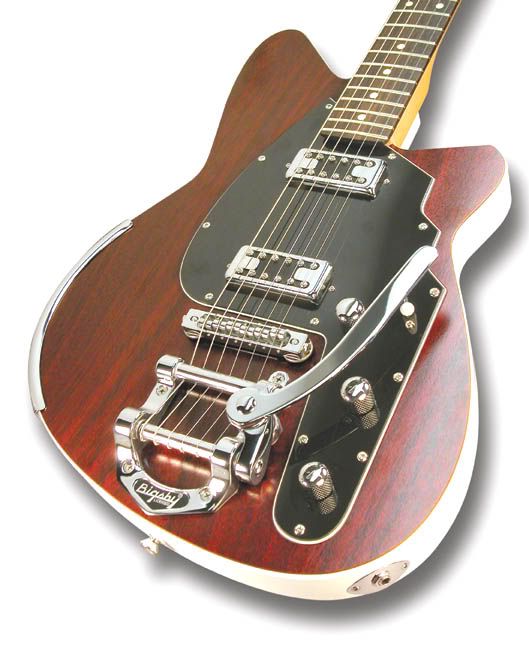 The first commercially successful tremolo/vibrato unit was the Bigsby vibrato tailpiece. It incorporates a spring loaded tremolo arm, or whammy bar that controls the tension of a bar that crosses all six strings. The bar raises or lowers to release or increase tension on the strings causing the pitch to lower or rise.
The first commercially successful tremolo/vibrato unit was the Bigsby vibrato tailpiece. It incorporates a spring loaded tremolo arm, or whammy bar that controls the tension of a bar that crosses all six strings. The bar raises or lowers to release or increase tension on the strings causing the pitch to lower or rise.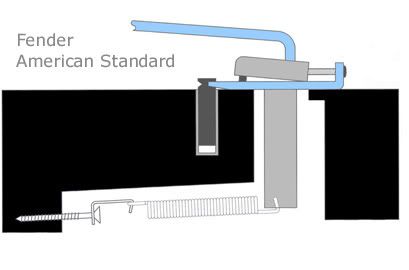 However, Due to these problems, Leo Fender created the synchronized tremolo which popularized the term tremolo (Leo was an engineer, not a musician).
However, Due to these problems, Leo Fender created the synchronized tremolo which popularized the term tremolo (Leo was an engineer, not a musician).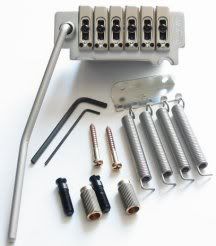 Just about any guitarist you can think of has, at one time or another played a guitar with this style tremolo bridge.
Just about any guitarist you can think of has, at one time or another played a guitar with this style tremolo bridge. Enter the Floyd Rose double-locking tremolo. This is probably the last truly significant change in tremolo/vibrato technology. While there have been improvements and tweeks, the double locking system revamped, again, the way people approached guitar playing.
Enter the Floyd Rose double-locking tremolo. This is probably the last truly significant change in tremolo/vibrato technology. While there have been improvements and tweeks, the double locking system revamped, again, the way people approached guitar playing.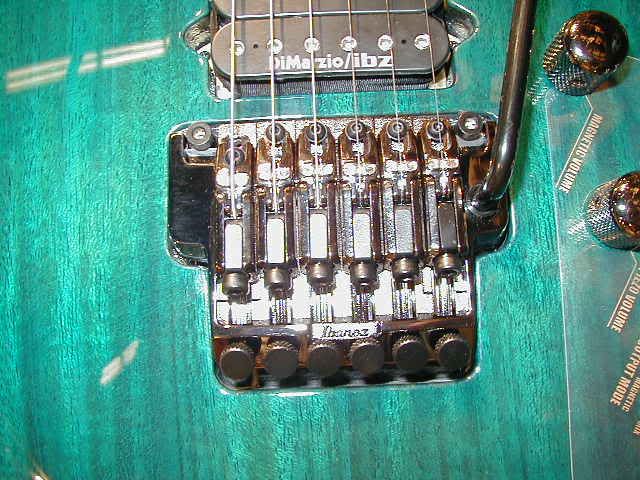 Recently, guitar manufacturer Ibanez introduced the Edge Pro style tremolo. It's very similar to the Floyd Rose style trem, but you don't have to cut the end of the string off and it eliminates many of the sharp edges that the Floyd Rose has.
Recently, guitar manufacturer Ibanez introduced the Edge Pro style tremolo. It's very similar to the Floyd Rose style trem, but you don't have to cut the end of the string off and it eliminates many of the sharp edges that the Floyd Rose has.
 The song is a fun piece of solid rock guitar. One of the things a lot of modern instrumental guitarists get into is weird time signatures and progressive time changes, but not Joe. He’s a solid 4-4 rock and roller. And it’s damn cool. This song is a solid assault of slipstream cosmic coolness, like the comic-book character from which the song was inspired.
The song is a fun piece of solid rock guitar. One of the things a lot of modern instrumental guitarists get into is weird time signatures and progressive time changes, but not Joe. He’s a solid 4-4 rock and roller. And it’s damn cool. This song is a solid assault of slipstream cosmic coolness, like the comic-book character from which the song was inspired. I hear strings sing when I say goodnight.
I hear strings sing when I say goodnight.  When I come back to an artist (usually months, sometimes years, later) I still have a strong connection with the music because of such previous studious listening.
When I come back to an artist (usually months, sometimes years, later) I still have a strong connection with the music because of such previous studious listening.
 G3, Atlanta, 31 days from now. Last week I talked about guitarist Paul Gilbert, one of the 3 guitarists on this tour. This week I’m going to take a little different tact talking about another guitarist. I’m going to talk about John Petrucci’s
G3, Atlanta, 31 days from now. Last week I talked about guitarist Paul Gilbert, one of the 3 guitarists on this tour. This week I’m going to take a little different tact talking about another guitarist. I’m going to talk about John Petrucci’s  I was burning out at the time was The Breeders’ Pod. One of the songs often replayed (the meat, FINALLY!, such a circuitous route to get here, eh?) was their cover of The Beatles’ Happiness is a Warm Gun. The other day, that song popped up in rotation on my MP3 player and I thought, “What a good topic for a column!”
I was burning out at the time was The Breeders’ Pod. One of the songs often replayed (the meat, FINALLY!, such a circuitous route to get here, eh?) was their cover of The Beatles’ Happiness is a Warm Gun. The other day, that song popped up in rotation on my MP3 player and I thought, “What a good topic for a column!” 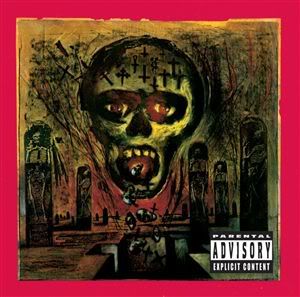
 My style didn’t really fit in there. This was 1988. I was moving to a place where half of the population came from farms or ranches. So, the cowboy look was big. There was, of course, the standard high school prep. And there were those into heavy metal and hard rock – long hair, blue jean or leather jackets and T shirts were the uniform. I didn’t fit in with any of them. My clothes were all black. I wore old military fatigues with hand-painted band logos on them. I had a recently cut mohawk. Everyone was into Guns and Roses and Poison. I was into the Misfits and Suicidal Tendencies.
My style didn’t really fit in there. This was 1988. I was moving to a place where half of the population came from farms or ranches. So, the cowboy look was big. There was, of course, the standard high school prep. And there were those into heavy metal and hard rock – long hair, blue jean or leather jackets and T shirts were the uniform. I didn’t fit in with any of them. My clothes were all black. I wore old military fatigues with hand-painted band logos on them. I had a recently cut mohawk. Everyone was into Guns and Roses and Poison. I was into the Misfits and Suicidal Tendencies.  That said, there are some pitfalls to capitalism. One of the areas that suffer greatly under a capitalist system is the arts. When everything is a commodity, people are more interested in marketing what sells than what may be the newest or most innovative. And one area where this is very evident is in music.
That said, there are some pitfalls to capitalism. One of the areas that suffer greatly under a capitalist system is the arts. When everything is a commodity, people are more interested in marketing what sells than what may be the newest or most innovative. And one area where this is very evident is in music.  In Dec. 1993, my wife (then fiancé) and I made the hour trek to the UNO Lakefront Arena in New Orleans to see Nirvana. The Breeders were the opening band. I admit that I was really going to see them. While Nirvana is still a guilty pleasure (and I’m not that big a fan any more), I am still in love with The Breeders. Anyone who was a part of such a great musical entity as The Pixies and then continued to put out great music in her own project is deserving of praise. Kim Deal has long been one of my favorite musicians.
In Dec. 1993, my wife (then fiancé) and I made the hour trek to the UNO Lakefront Arena in New Orleans to see Nirvana. The Breeders were the opening band. I admit that I was really going to see them. While Nirvana is still a guilty pleasure (and I’m not that big a fan any more), I am still in love with The Breeders. Anyone who was a part of such a great musical entity as The Pixies and then continued to put out great music in her own project is deserving of praise. Kim Deal has long been one of my favorite musicians. 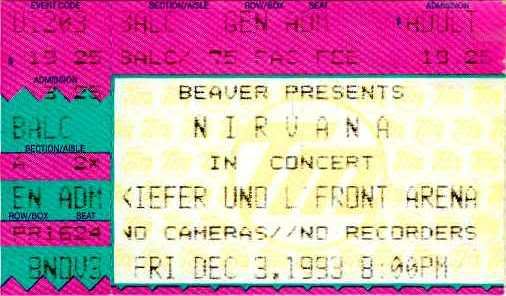 Here is a copy of a ticket to the show. It’s not mine, but it’s from the same show. I had kept them for years, but I don’t know if I could even find it or if I threw it out or not. It’s a shame, in retrospect. The important thing to notice here is that only Nirvana is listed on the ticket, no other bands.
Here is a copy of a ticket to the show. It’s not mine, but it’s from the same show. I had kept them for years, but I don’t know if I could even find it or if I threw it out or not. It’s a shame, in retrospect. The important thing to notice here is that only Nirvana is listed on the ticket, no other bands.  For those of you how don’t know who Shonen Knife are they are an all-girl Japanese band. They play punk pop, a la The Ramones, but very poorly. If you want to hear them, watch Cartoon Network some time and you will eventually hear them.
For those of you how don’t know who Shonen Knife are they are an all-girl Japanese band. They play punk pop, a la The Ramones, but very poorly. If you want to hear them, watch Cartoon Network some time and you will eventually hear them.  We arrived at the arena. Got in and started making our way to our seats. No sooner had we walked through the doors into the balcony seating than I heard a strange, painful noise. I looked at the stage and turned to my fiancé. “No way! I said. It’s Shonen Knife!”
We arrived at the arena. Got in and started making our way to our seats. No sooner had we walked through the doors into the balcony seating than I heard a strange, painful noise. I looked at the stage and turned to my fiancé. “No way! I said. It’s Shonen Knife!” 
 Over time, my listening interests have grown. I grew up on country, gospel and classical. My rebellion to that was metal and punk. Since then, my appreciation for music has grown to accept those forms from my youth and multitudes of other forms of music since.
Over time, my listening interests have grown. I grew up on country, gospel and classical. My rebellion to that was metal and punk. Since then, my appreciation for music has grown to accept those forms from my youth and multitudes of other forms of music since.


 My rhythms shattered concrete his leads did sever.
My rhythms shattered concrete his leads did sever. 
 Alex Skolnick has long been a favorite guitarist of mine. I picked up on Testament when the released their “Legacy” album. Sure, musically they were very derivative of Metallica (pre-sell out Black album), but there was one thing that set them apart – Skolnick. Alex has always been a hell of a guitarist playing just enough to match the music, choosing his notes carefully and using cutting, clear tone.
Alex Skolnick has long been a favorite guitarist of mine. I picked up on Testament when the released their “Legacy” album. Sure, musically they were very derivative of Metallica (pre-sell out Black album), but there was one thing that set them apart – Skolnick. Alex has always been a hell of a guitarist playing just enough to match the music, choosing his notes carefully and using cutting, clear tone. 

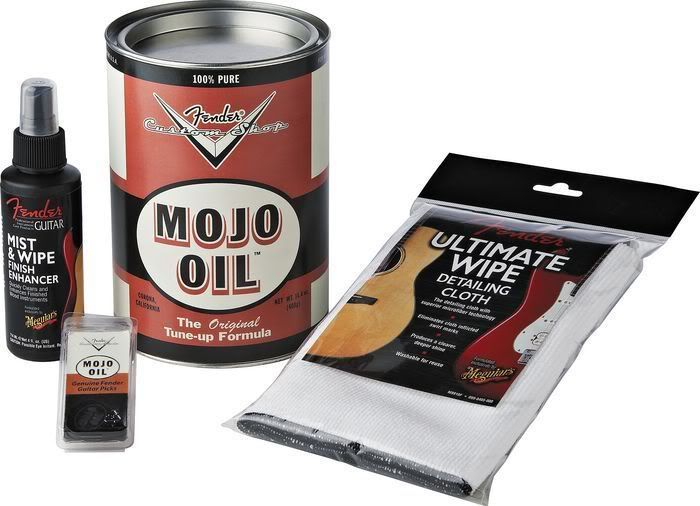

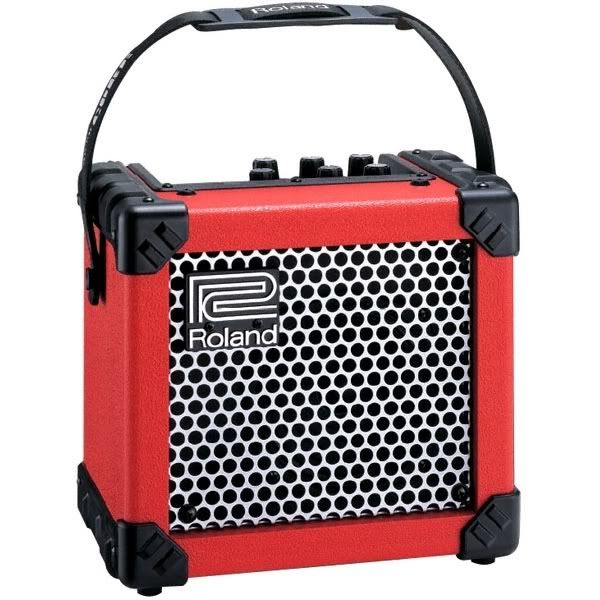



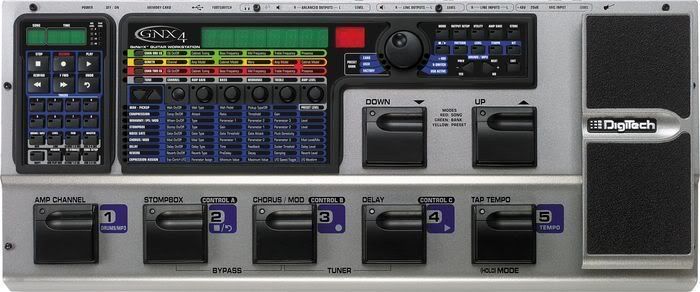
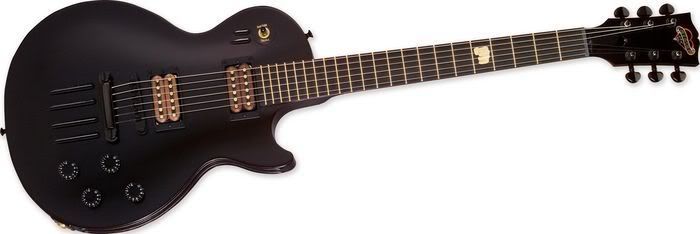
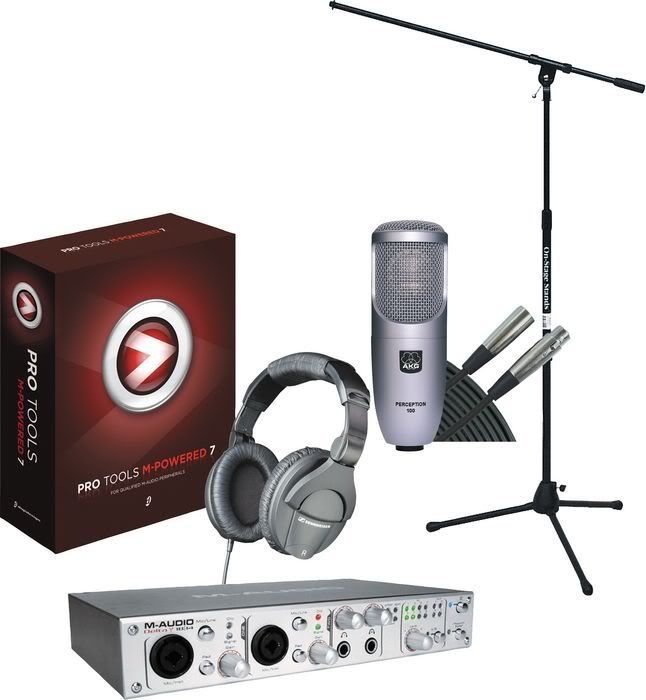
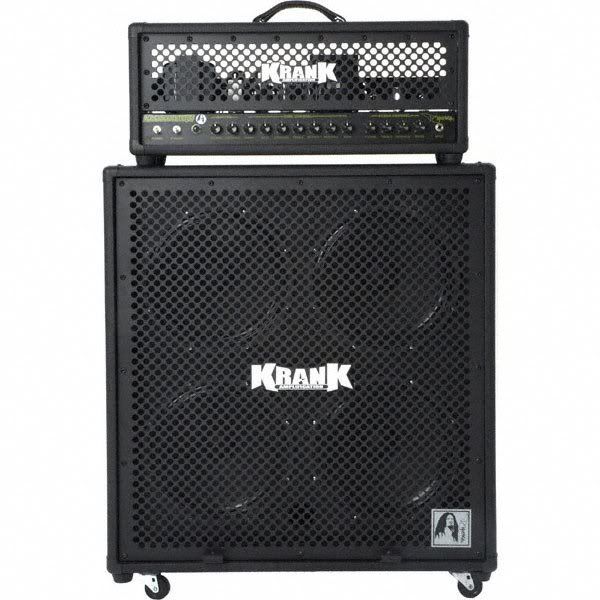
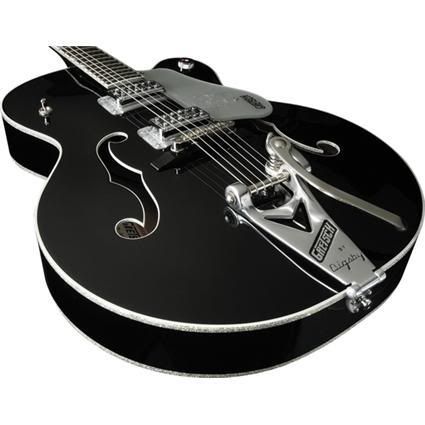
 There are already far more proficient people doing a far better job of that than I ever could. The idea is that I would, perhaps, introduce folks to guitarists they didn’t know much about, share my love with other people, and talk about some history and technical aspects of the instrument. To that end, I usually switch weeks – one week I’ll focus on a guitarist or band and the next I’ll do a “tech” article.
There are already far more proficient people doing a far better job of that than I ever could. The idea is that I would, perhaps, introduce folks to guitarists they didn’t know much about, share my love with other people, and talk about some history and technical aspects of the instrument. To that end, I usually switch weeks – one week I’ll focus on a guitarist or band and the next I’ll do a “tech” article.  Cropper has performed on some of the most influential soul and early rock and roll music that this country has produced. Additionally, he and fellow session musician Booker T. Jones formed Booker T. and the MGs. Their track
Cropper has performed on some of the most influential soul and early rock and roll music that this country has produced. Additionally, he and fellow session musician Booker T. Jones formed Booker T. and the MGs. Their track 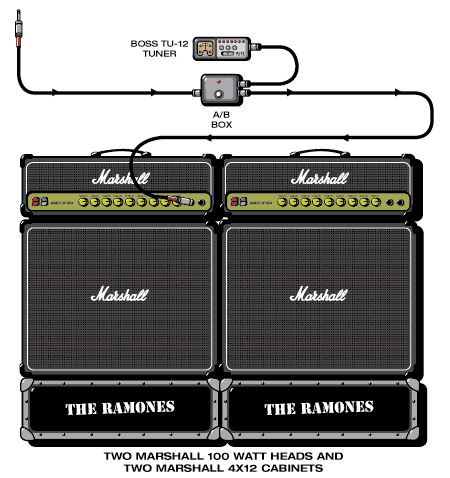
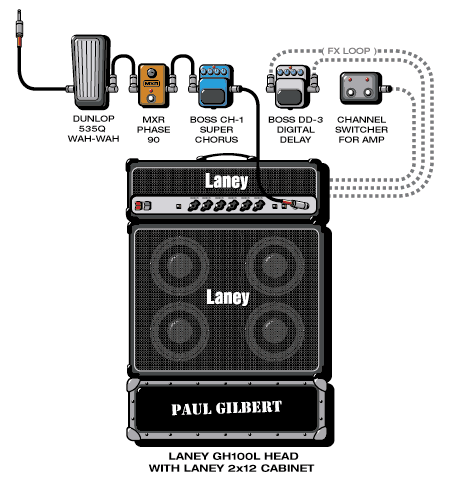
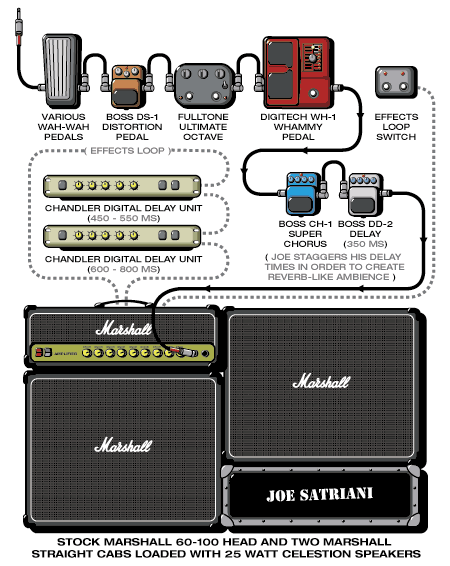




 grain. This is okay for a while, but eventually sanding is just not an option as you are taking away from the thickness of the neck.
grain. This is okay for a while, but eventually sanding is just not an option as you are taking away from the thickness of the neck. 















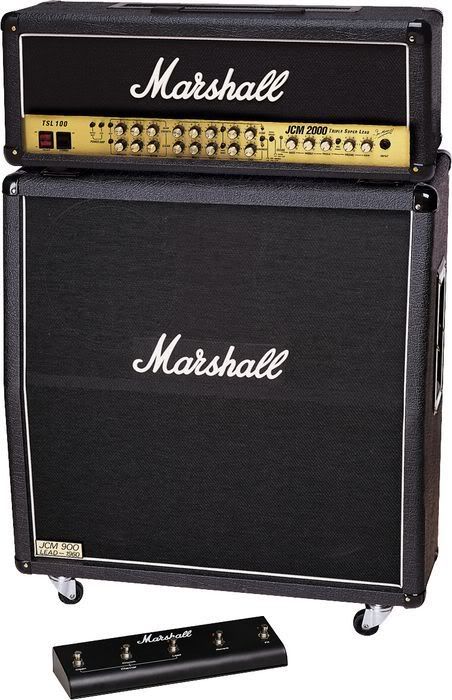
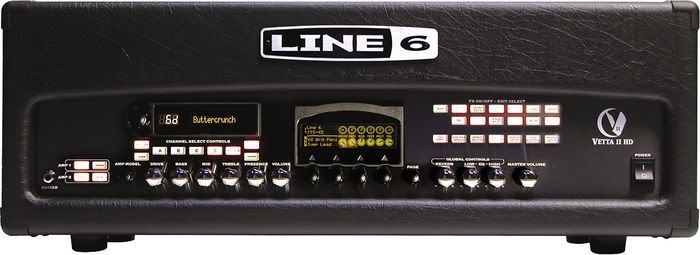
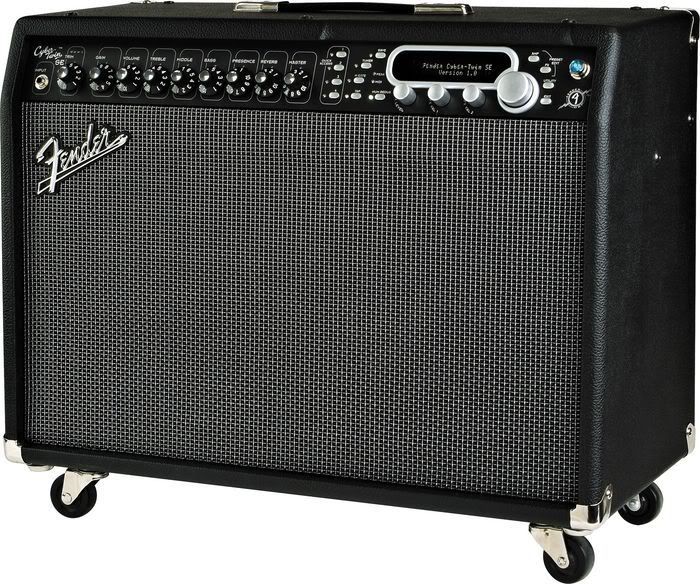
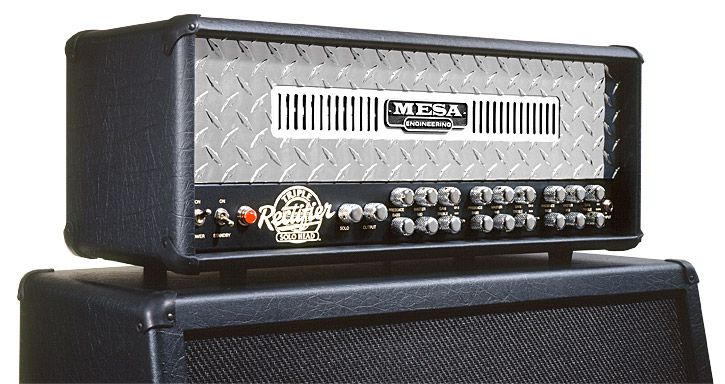


 Listening to "Little Wonder," you wonder at some of the sounds that Reeves got from his guitar. If you happened to see Bowie perform on Saturday Night Live in this era, you got to see Reeves rip out some wild guitar work.
Listening to "Little Wonder," you wonder at some of the sounds that Reeves got from his guitar. If you happened to see Bowie perform on Saturday Night Live in this era, you got to see Reeves rip out some wild guitar work.



 There are Wes Montgomery's cascading notes, Les Paul's killer tone and tasteful licks, Dave Gilmour's economically chosen notes, and many others. Chet Atkins is a leader among these guitarists. A man of such talent and such good taste, we'll be talking about his playing for decades to come.
There are Wes Montgomery's cascading notes, Les Paul's killer tone and tasteful licks, Dave Gilmour's economically chosen notes, and many others. Chet Atkins is a leader among these guitarists. A man of such talent and such good taste, we'll be talking about his playing for decades to come. This is my stuff bag. Sure, I got it free when I joined the Book of the Month club, but it doesn't really matter what king of freakin' bag it is. Just that the bag works for you. I don't care how nice that guitar case or gig bag is. If you play outside your home, you have a guitar stuff bag. Something you use to throw your cables and other gear into.
This is my stuff bag. Sure, I got it free when I joined the Book of the Month club, but it doesn't really matter what king of freakin' bag it is. Just that the bag works for you. I don't care how nice that guitar case or gig bag is. If you play outside your home, you have a guitar stuff bag. Something you use to throw your cables and other gear into. After writing a post about The Reverend Horton Heat, I decided talk a little bit about
After writing a post about The Reverend Horton Heat, I decided talk a little bit about